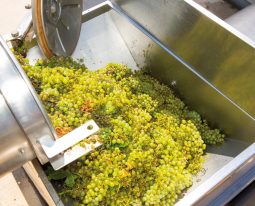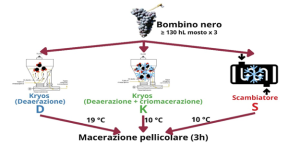
As is well known, the quality and characteristics of a wine depend on multiple factors. Over all the raw material, the grapes, to follow all the winemaking processes and, to close the cycle, the various ways in which the finished product is stored and put into bottles.
It follows that having a potentially suitable raw material for the purpose at hand, the rest depends on how one works on it, from the moment of its detachment from the vine to its transformation into a finished product.
These operations are related to the processes and equipment available in the winery.
In this context, food gases can play a key role if integrated properly and with appropriate technologies into the winemaking process.
Crifo Wines – Cantina Ruvo di Puglia (BA) has a long tradition behind it. It was born in 1960 from the cooperative association of 28 winemakers, who joined forces to have greater bargaining power in selling grapes to large national groups. Over the course of its history, however, members have broadened and broadened their horizons, turning it into one of the most important in southern Italy, capable of enhancing the native varieties of
Apulian grape varieties and transform them into wines that tell the story of the qualities of a unique and elegant territory that develops at the foot of Castel del Monte. The Crifo brand under which the winery signs its creations comes from its historical name, which is “Cantina della Riforma Fondiaria,” but it is also a way of paying homage to the Griffin carved on the facade of Ruvo di Puglia Cathedral, the mythological animal placed to protect the people of Ruvo. Today the Cooperative has over 400 members and receives contributions exceeding the 8,000 tons of grapes per harvest, processing some of the most representative Apulian grape varieties such as Nero di Troia, Bombino bianco and Bombino nero, the latter being very suitable for the rosé vinifications the case study deals with.
Crifo Wines, in its quest to optimize quality in the rosé vinification of Bombino nero, has set itself the goal of implementing it by intervening in the cryomaceration phase. Massimo Tripaldi, winery winemaker, explains the reasons as follows:
“Bombino nero is a grape variety that can provide exceptional rosé wines. We are convinced that careful conduct of pre-fermentation operations is essential to allow this grape variety to express its full potential, and technological innovation can come to our aid ”.
SIAD, the Crifo-Wines and with the cooperation of the prof. Vito Paradiso, professor of oenology at the University of Salento have developed a research plan that took the form, in the 2022 vintage, in an industrial-scale trial where about 750 q of pressed, operating with two different technologies:
The experimentation allowed the comparison of three different modes of operation:

The results obtained highlighted numerous aspects of the potential of the Kryos technology of deaeration and refrigeration of crushed grapes in the rosé winemaking of Bombino nero. Compared with tube-to-tube exchanger refrigeration, this approach resulted in a shift in the extraction pattern of volatile and nonvolatile substances during pellicular maceration. In this regard, Vito Paradiso highlights how”
Kryos technology resulted in a limited extraction of anthocyanins and total polyphenols, while enriching the wine in terms of primary aromas. The profile of fermentation volatile compounds was also affected by the use of this technique. These effects were reflected in the wine’s olfactory profile, which was made more complex and characterized by the appearance of floral notes.”
The complete and detailed results of the trial have been published by Infowine, one of the leading web magazines on viticulture and oenology issues.
Regarding the operational management of Kryos in the winery supply chain, Massimo Tripaldi highlights the two aspects that he considers most relevant: “the ease of use and the operational versatility, which allow this technology to be adapted to different purposes.
Regarding the wine produced, what struck most were the intensity and olfactory complexity. The label for which the use of Kryos was tested found a very positive response in the market. ”
In the wake of the experience, the group that conducted it has developed a further project to expand it, envisaging a new experiment that can Compare the traditional, mechanical frigorie methodology, with Kryos technology, the latter using both nitrogen (N₂)and carbon dioxide (CO₂) in the liquid state as refrigerants. The project won the 2023 edition of the SIAD-OICCE International Award for Innovation in the Use of Technical Gases in Viticulture and Enology, and its implementation will take place during the 2023 grape harvest, again by the Crifo-Wines winery in Ruvo di Puglia. At the end, there will be enough evidence to compare the performance between cryomaceration with the traditional method and that with 2 different types of cryogenic frigories: the “Kryomaceration” with CO₂ or with N₂.
Learn more about our offer for wineries or to find out more write to: foodandbeverage@siad.eu.
About us
SIAD Group, a century of history in gas production
Among Italy’s leading chemical groups, SIAD is a leader in the production and commercialization of the full range of industrial, specialty, and medicinal gases and related services. The business extends to sectors in synergy with that of gases, including Wine, Food and Beverage.